Diaspora Organizations and their Humanitarian Response in Myanmar
21 February 2022

This Real-Time Report is part of the Diaspora Emergency Action & Coordination Initiative (DEMAC) “Research study on diaspora humanitarian response and engagement”.
The Real-Time Report investigates from November 2021 – January 2022 how Myanmar diaspora organizations engage with the current crisis in Myanmar, how they mobilize funding, what their advocacies are and who they partner or coordinate with on the ground to support the people most in need of humanitarian assistance.
DEMAC, together with external consultants, undertook an initial rapid review to map the structures and activities of 30 diaspora organizations involved in the response. Semi-structured interviews with 21 people representing diaspora organizations, international humanitarian organizations and people affected by the crisis were conducted. Social media posts from the Facebook accounts of 30 diaspora organizations were also monitored over a six-week period.
The Myanmar Context
In February 2021, the Myanmar military, the Tatmadaw, seized power through brutally repressing the population, resulting in a “deep human rights, humanitarian, and economic crisis”. The crisis is compounded by deepening economic recession, the global pandemic, health system collapse, and surging poverty and food insecurity.
As of 6 December 2021, this crisis had already displaced 284,700 people across Myanmar. A further 25,000 refugees have been displaced to neighboring countries. The UN has documented over 1,000 civilians killed and 8,000 arbitrarily detained. Many have been tortured—including children.
The Diaspora – Lifelines to Myanmar
Myanmar has an extensive, active, and committed diaspora. The type of support prioritized is independent of international aid categories of humanitarian assistance, human rights, protection or direct support for politics and civil disobedience. Their activities are largely in parallel and separate to the existing humanitarian architecture. The diaspora is mainly engaged in activities such as fundraising, advocacy, education, settlement assistance and documentation of human rights abuses.
As of 2021, over 3 million Myanmar nationals have migrated internationally, primarily to Thailand, Malaysia, the United Kingdom, and Japan. Close to 2 million Myanmar nationals live in neighboring Thailand, the largest destination for Burmese migrants.
Key challenges for Myanmar Diasporas
Unsurprisingly, the key challenges for diaspora organizations are funding and resources, as well as access. Many organizations operate on a voluntary basis, necessarily limiting the time available from their members. For diaspora organizations supporting the civil disobedience movement, providing support can be particularly dangerous, especially when using Hundi and communicating through underground networks.
Recognition by the International Humanitarian Community
The international humanitarian community recognizes the unique value offered by diaspora organizations—their reach in areas inaccessible to international actors, access to real-time information and people, some of whom may move regularly, and ability to act informally and relatively quickly, unrestrained by formal bureaucracy. They have an ability to meet needs that are impossible for the international community to address.
Announcements
21 May 2025
Open letter: Malaysia must lead ASEAN with principle, not hypocrisy, to address the Myanmar crisis

Progressive Voice is a participatory rights-based policy research and advocacy organization rooted in civil society, that maintains strong networks and relationships with grassroots organizations and community-based organizations throughout Myanmar. It acts as a bridge to the international community and international policymakers by amplifying voices from the ground, and advocating for a rights-based policy narrative.